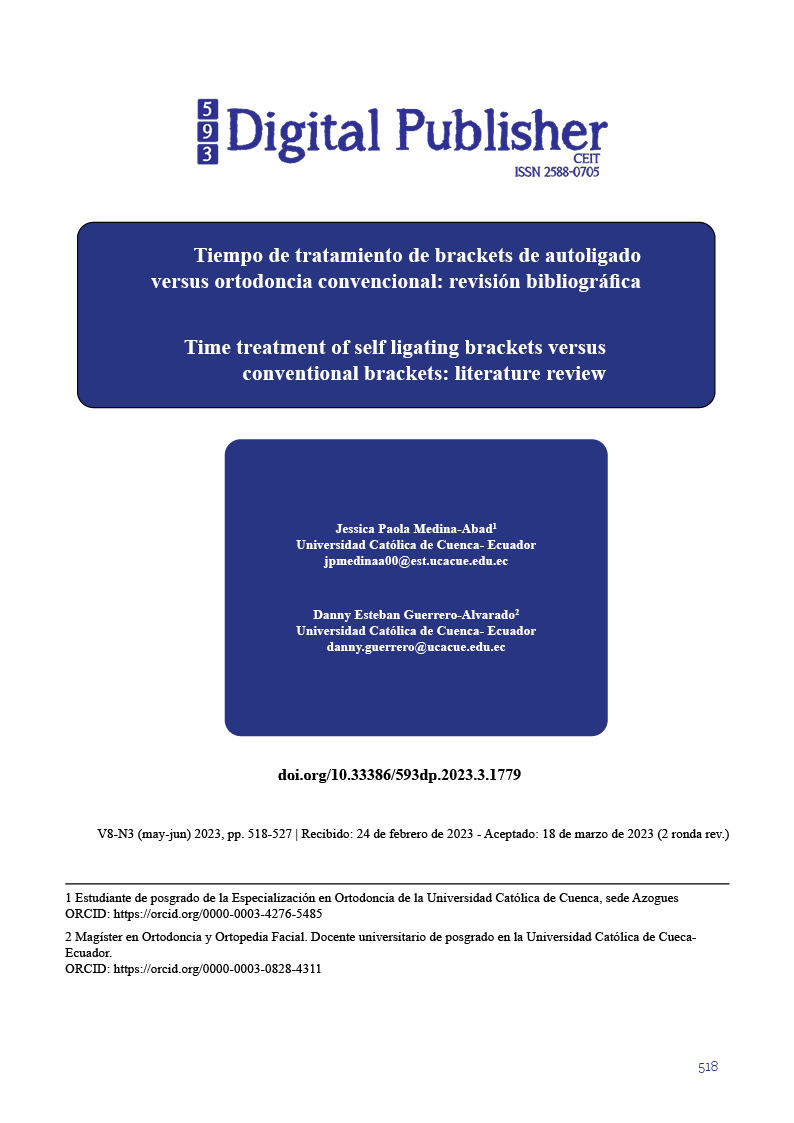Tiempo de tratamiento de brackets de autoligado versus ortodoncia convencional: revisión bibliográfica
Contenido principal del artículo
Resumen
Los brackets son aparatos de corrección empleados en casos de problemas dentales como apiñamiento, mordidas abiertas, entre otros. Con el pasar del tiempo, los brackets han ido avanzando en el diseño y materiales empleados para su elaboración, pasando desde brackets convencionales con gomas y ligaduras metálicas hasta brackets autoligados, cuyo sistema incorporado le permite sujetarse al arco. En este sentido, el objetivo de esta revisión va dirigido a comparar el tiempo de tratamiento entre los brackets de autoligado versus la ortodoncia convencional. Para ello, se seleccionaron 50 artículos de diversas bases de datos, considerando que los mismos estuvieran relacionados con el tiempo de tratamiento. Tanto los brackets convencionales como los autoligados poseen sus propias características y funciones, sin embargo, hasta ahora no se ha demostrado la efectividad de un tratamiento sobre otro en cuanto al tiempo. Es importante resaltar el tiempo de tratamiento va en dependencia del tipo de mal oclusión y la cooperación del paciente.
Descargas
Detalles del artículo

Esta obra está bajo una licencia internacional Creative Commons Atribución-NoComercial-CompartirIgual 4.0.
1. Derechos de autor
Las obras que se publican en 593 Digital Publisher CEIT están sujetas a los siguientes términos:
1.1. 593 Digital Publisher CEIT, conserva los derechos patrimoniales (copyright) de las obras publicadas, favorece y permite la reutilización de las mismas bajo la licencia Licencia Creative Commons 4.0 de Reconocimiento-NoComercial-CompartirIgual 4.0, por lo cual se pueden copiar, usar, difundir, transmitir y exponer públicamente, siempre que:
1.1.a. Se cite la autoría y fuente original de su publicación (revista, editorial, URL).
1.1.b. No se usen para fines comerciales u onerosos.
1.1.c. Se mencione la existencia y especificaciones de esta licencia de uso.
Citas
Alpern CM. (2008). Gaining control with self-ligation. Seminary in Orthodontics, 14(1): 73-86.
Aramburu V, Ortopeda A, (2009). Ustrell, T et al. History of self-ligation. Ortodon Clínic. 12 (4): 20-48.
Baccetti T, Franchi L, Camporesi M, Defraia E, Barbato E. (2009). Forces produced by different nonconventional bracket or ligature systems during alignment of apically displaced teeth. Angle Orthod, 79(3):533-9
Burrow SJ. (2009). Friction and resistance to sliding in orthodontics: a critical review. Am J Orthod Dentofac Orthop, 135 (4):442-7.
Castro RM, Neto PS, Horta MC, Pithon MM, Oliveira DD. (2013). Comparison of static friction with self-ligating, modified slot design and conventional brackets. J Appl Oral Sci., 21(4):314-319.
Čelar, A. G., Schedlberger, M., Doerfler, P., & Bertl, M. H. (2013). Systematic review on self-ligating vs. conventional brackets: initial pain, number of visits, treatment time. Journal of Orofacial Orthopedics/Fortschritte der Kieferorthopädie, 74(1), 40-51. https://doi.org/10.1007/s00056-012-0116-x
Chen S, Greenlee G, Kim J, Smith C, Huang G. (2010). Systematic review of self-ligating brackets. Am J Orthod Dentofacial Orthop.; 137 (726):721-726.
Chen SS-H, Greenlee GM, Kim J-E, Smith CL, Huang GJ. (2010). Systematic review of self-ligating brackets. Am J Orthod Dentofac Orthop, 137 (6): 726.
Corghi RG, Malavazi DF, Quintela MM, Aquino DR, da Silva HG, Roman-Torres CV. (2014). Evaluation of periodontal clinical parameters of patients with orthodontic appliances with conventional and self-ligating brackets. Braz J Periodontol. 24:30–4.
Do Nascimento LE, Pithon MM, Ruellas AO, et al. (2020) Rates of tooth movement and bone remodeling activity: Self-ligating versus conventional brackets. J Clin Exp Dent, 12(4).
Eberting, J. J., Straja, S. R., y Tuncay, O. C. (2001). Treatment time, outcome, and patient satisfaction comparisons of Damon and conventional brackets. Clinical Orthodontics and Research, 4(4), 228-234. https://doi.org/10.1034/j.1600-0544.2001.40407.x
Ehsani S, Mandich MA, El-Bialy TH, Flores-Mir C. (2009). Frictional resistance in selfligating orthodontic brackets and conventionally ligated brackets. A systematic review. Angle Orthod, 79(3):592-601
Farhadifard H, Keshvad M, Hesamaref A, et al. (2019). Possible Advantages of Self-Ligating Brackets: From Claims to Evidence, a Literature Review. Iran J Ortho. 14(1):e90579
Fleming PS, Johal A. (2010). Self-ligating brackets in orthodontics. A systematic review. Angle Orthod. 80: 575–584.
Gebeile-Chauty S. (2014). Are self-ligating brackets an advantageous alternative for non-extraction treatments? J Dentofacial Anom Orthod, 17(402):1-11
Green J. (2014). The origins and evolution of fixed orthodontic appliances. Dental Nursing, 10(9):524–528. file:///C:/Users/Usuario/Downloads/Green2014a.pdf
Harradine NWT (2003). Self-ligating brackets: where are we now? J Orthod.; 30(3):262-73. http://www.adenta.com/uploads/4/2/1/6/42164229/201_-_self-ligating_brackets_where_are_we_now.pdf
Harradine, N. W. (2001). Self‐ligating brackets and treatment efficiency. Clinical orthodontics and research, 4(4), 220-227. https://doi.org/10.1034/j.1600-0544.2001.40406.x
Hempel, G. Sat, M, Vargas, V.y Diaz, A. (2021). Comparación de Brackets de Autoligado y Brackets Convencionales basada en la evidencia. Odontoestomatología. 23 (38) e302. https://doi.org/10.22592/ode2021n37e302.
Henao SP, Kusy RP. (2005) Frictional evaluations of dental typodont models using four self-ligating designs and a conventional design. Angle Orthod, 75 (1):75-85.
Hennessy J, Al-Awadhi EA. (2016). Clear aligners’ generations and orthodontic tooth movement. J Orthod, 43(1):68-76.
Howard C M, Birdsall J, Hunt NP, Sabbah W. (2012). Accuracy of positioning three types of self-ligating brackets compared with a conventionally ligating bracket. J Orthod. 39(1): 34-42. https://www.hindawi.com/journals/bmri/2022/5128870/#conclusion
Jacobs, C., Gebhardt, P.F., Jacobs, V. et al. (2014). Root resorption, treatment time and extraction rate during orthodontic treatment with self-ligating and conventional brackets. Head Face Med; 10 (2).
Jakob S, Matheus D, Jimenez-Pellegrin M, Turssi C, Amaral F. (2014). Comparative study of friction between metallic and conventional interactive self-ligating brackets in different alignment conditions. Dental Press J Orthod, 19(3):82-89. https://www.ncbi.nlm.nih.gov/pmc/articles/PMC4296631/
Johanssona K. (2012). Orthodontic treatment efficiency with self-ligating and conventional edgewise twin brackets A prospective randomized clinical trial. Angle Orthodontist. 82(5):929-930.
Keim RG, Gottlieb EL, Nelson AH, Vogels DS. (2008). JCO study of orthodontic diagnosis and treatment procedures Part 1: results and trends. J Clin Orthod, 42(11):625–640.
Khan H, Mheissen S, Iqbal A, Jafri AR, Alam MK. (2022). Bracket Failure in Orthodontic Patients: The Incidence and the Influence of Different Factors. Biomed Res Int.
Kusy R. (2002) Orthodontic Biomaterials: From the Past to the Present. The Angle Orthodontist, 72 (6): 501–512. https://meridian.allenpress.com/angle-orthodontist/article/72/6/501/57656/Orthodontic-Biomaterials-From-the-Past-to-the
Leitea V, Contib AC, Navarrob R, Almeidab M, Oltramari-Navarrob P, et al. (2012) Comparison of root resorption between self-ligating and conventional preadjusted brackets. Angle Orthod, 82(6):1078-1082.
Li, Y., Mei, L., Wei, J. et al. (2019). Effectiveness, efficiency and adverse effects of using direct or indirect bonding technique in orthodontic patients: a systematic review and meta-analysis. BMC Oral Health 19, 137. https://doi.org/10.1186/s12903-019-0831-4
Loh KW. (2007). Rapid tooth movement with a low-force, low-friction bracket system. J Clin Orthod.; 41:451–457.
Machibya FM, Bao X, Zhao L, Hu M. (2013). Treatment time, outcome, and anchorage loss comparisons of self-ligating and conventional brackets. Angle Orthod, 83:280–285
Miles PG. (2005). Smartclip versus conventional twin brackets for initial alignment: is there a difference. Aust Orthod J 21:123-7.
Miles PG. (2007) Self-ligating vs conventional twin brackets during en-masse space closure with sliding mechanics. Am J. Orthod. Dentofacial Orthop, St Louis. 132 (2):233-225.
Miles PG. (2009). Self-ligating brackets in orthodontics: do they deliver what they claim? Aust Dent J. 54: 9-11. https://onlinelibrary.wiley.com/doi/epdf/10.1111/j.1834-7819.2008.01081.x
Moyano J, Motagut D, Perera R, et al. (2020). Comparison of changes in the dental transverse and sagittal planes between patients treated with self-ligating and with conventional brackets. Dental Press J. Orthod. 25 (01): 47-55.
Nabhan AF, Abbas NH, (2016). Fleming PS, Johal A, Sadek MM. Self‐ligating brackets versus conventional pre‐adjusted edgewise brackets for treating malocclusion. Cochrane Database Syst Rev, (10): CD012407.
Nivethigaa, B. Aravind, S. y Remmiya M. (2021). Effect of Method of Ligation on the Pain Perception during Orthodontic Treatment. An Rct using Conventional Metal and Dual Activation Self-Ligating Brackets. Int. J. Life Sci. Pharma Res.11 (1), L86-90 http://dx.doi.org/10.22376/ijpbs/lpr.2021.11.1.L86-90
O´Dywer, L. Littlewood, S. Rahman, Sh. James, R. Barber, S. Russell, J. (2016). A multi-center randomized controlled trial to compare a self-ligating bracket with a conventional bracket in a UK population: Part 1: Treatment efficiency. Angle Orthodontist, 86 (1). DOI: 10.2319/112414837.1
Ong E, McCallum H, Griffin MP, Ho C. (2010). Efficiency of self-ligating vs conventionally ligated brackets during initial alignment. Am J Orthod Dentofacial Orthop. (138): 1– 7
Ousehal L, Lazrak L, Es-Said R, Hamdoune H, Elquars F, Khadija A. (2011). Evaluation of dental plaque control in patients wearing fixed orthodontic appliances: A clinical study. Int Orthod. 9:140–55.
Paduano S, Cioffi I, Iodice G, Rapuano A, Silva R. (2008) Time efficiency of self-ligating vs conventional brackets in orthodontics: effect of appliances and ligating systems. Prog Orthod, 9:74–80.
Pandis N, Polychronopoulou A, Makou M, Eliades T. (2010). Mandibular dental arch changes associated with treatment of crowding using self-ligating and conventional brackets. Eur J Orthod.; 32(3):248-53
Patil S, Jakati S. (2017). Self-ligating brackets: A review. Karnataka: Lambert Academic Publishing;
Pesce, R. E., Uribe, F., Janakiraman, N., Neace, W. P., Peterson, D. R., & Nanda, R. (2014). Evaluation of rotational control and forces generated during first-order archwire deflections: a comparison of self-ligating and conventional brackets. The European Journal of Orthodontics, 36(3), 245-254. https://doi.org/10.1093/ejo/cjr119
Pradeep S. (2014). Determination of microbiological flora of different hygienic ligatures techniques – An in vivo study. Int J Curr Microbiol Appl Sci. 3:739–46.
Proffit W. (2001).Aparatología fija actual. Ortodoncia Contemporánea: Teoría y Práctica. 3era Madrid: Harcourt SA. https://ortodonciasigloxx.files.wordpress.com/2016/06/00269ortodoncia-contemporanea-proffit-5a-ed_booksmedicos-org.pdf
Sepolia S, Kushwah APS, Natt AS, Vashisht L, Sahoo SK, Subudhi SK. (2016). Retrospective Analysis of Different Bracket Systems used in the Treatment of Patients with Anterior Crowding: A Longitudinal Comparative Study. J Contemp Dent Pract, 17(8):687-691.
Songra G, Clover M, Atack NE, et al. (2014). Comparative assessment of alignment efficiency and space closure of active and passive self-ligating vs conventional appliances in adolescents: a single-center randomized controlled trial. Am J Orthod Dentofacial Orthop., 145:569–578.
Tantidhnazet S, Leehathorn P, Rattanasumawong S, et al. (2018). Comparison of self-ligating bracket and conventional bracket in orthodontic treatment: A systematic review. M Dent J; 38 (3): 213-228 https://dt.mahidol.ac.th/en/wp-content/uploads/2018/05/04-Comparison-of-self-ligating.pdf
Tecco S, Festa F, Caputi S, et al. (2005) Friction of Conventional and Self-Ligating Brackets Using a 10 Bracket Model. Angle Orthod 75 (6): 1041–1045. https://meridian.allenpress.com/angleorthodontist/article/75/6/1041/58220/Friction-of-Conventional-and-Self-Ligating
Tecco, S., D'Attilio, M., Tetè, S., & Festa, F. (2009). Prevalence and type of pain during conventional and self-ligating orthodontic treatment. European journal of orthodontics, 31(4), 380–384. https://doi.org/10.1093/ejo/cjp003
Torres C, Cabrilla C, Quintanilla D. (2005). Comparative assesment of the effectiveness of dental alignment between low friction conventional ligated and self-closing brackets on the maxillary arch in 18 patients. Amsterdan, London: European Orthodontic Society.
Turnbull, N. R., & Birnie, D. J. (2007). Treatment efficiency of conventional vs self-ligating brackets: effects of archwire size and material. American Journal of Orthodontics and Dentofacial Orthopedics, 131(3), 395-399. https://doi.org/10.1016/j.ajodo.2005.07.018
Ustaoglu G, Korkmaz YN, Halicioglu K, Uysal Ö. (2019). Comparison of effects of bracket types and treatment duration on periodontal health of adult patients. APOS Trends Orthod, 9(2):94-8.
Yang X, Xue C, He Y, Zhao M, Luo M, Wang P. (2018). Transversal changes, space closure, and efficiency of conventional and self-ligating appliances. J Orofac Orthop. 79(1):1–10.
Yu, Z., Jiaqiang, L., Weiting, C. et al. (2014). Stability of treatment with self-ligating brackets and conventional brackets in adolescents: a long-term follow-up retrospective study. Head Face Med, 10 (41) 10-17 https://head-face-med.biomedcentral.com/articles/10.1186/1746-160X-10-41



